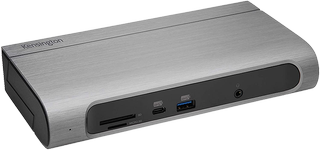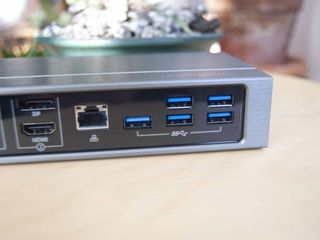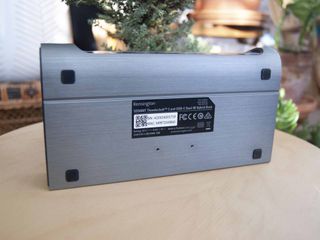Kensington has a wide variety of PC accessories, including some of the best docking stations on the market. For example, our Kensington Surface Pro Dock review outlines the best way to turn your Surface Pro into a mini Surface Studio. More recently, my Kensington SD2500T review highlights a compact dock that works well with both USB-C and Thunderbolt 3 laptops.
There are more than 20 different docks on Kensington's product landing page, so it's not too surprising that I've finally tested one that doesn't seem to work as intended. Here's what you need to know before you buy this dock.

Bottom line: The Kensington SD5600T is a well-built dock with plenty of ports, but it's not guaranteed to work all of the time. It often refuses to recognize attached accessories, including monitors, and it will sometimes entirely refuse to connect to a laptop. There are better options out there, including others from Kensington's vast lineup.
For
- Works with USB-C and Thunderbolt 3 devices
- Three-year warranty
- 15 total ports
- Up to 100W charging
- Vertical and horizontal orientation
Against
- Major performance issues
- No downstream Thunderbolt 3
- Chunky size
What I love about Kensington's SD5600T Thunderbolt 3 dock

The Kensington SD5600T is a well-built, if chunky, docking station. Its brushed aluminum shell gives way to glossy plastic panels that house the ports, with rubberized ends that allow you to set the dock up vertically with an included steel stand. The stand is heavy enough that there's not really a risk of the dock tipping over, even when laden with cables. Many docks are sticking with horizontal only; the vertical capability helps save space on your desk.
| Category | Spec |
|---|---|
| Connection | Thunderbolt 3 (40Gbps) USB-C Gen 2 (10Gbps) USB-C Gen 1 (5Gbps) |
| Front ports | USB-C 3.1 (Gen 2) USB-A 3.1 (Gen 2) 3.5mm audio SD/microSD readers |
| Rear ports | Five USB-A 3.1 (Gen 1) Ethernet Two DisplayPort 1.2 Two HDMI 2.0 Thunderbolt 3 (Host) |
| Max display res | Dual 4K@60Hz (TB3) Dual 2K@60Hz (USB-C) |
| Power delivery | Up to 100W |
| Dimensions | Horizontal: 7.76 (W) x 4.09 (D) x 1.45 (H) inches (197mm x 104mm x 36.8mm) |
| Weight | 1.84 pounds (0.84kg) |
| Warranty | 3 years |
This is a USB-C and Thunderbolt 3 dock, meaning it will work with more devices than a dock intended for just one interface. Depending on your laptop, docking capabilities will differ. A true Thunderbolt 3 connection allows for 40Gbps performance, whereas USB-C (Gen 2) hits 10Gbps and USB-C (Gen 1) hits just 5Gbps. This is standard stuff and applies to all docking stations that offer double connectivity. You're going to get up to 100W of charging power back to your laptop, which is enough for most laptops, even with notebook-class discrete graphics. It likely won't keep a gaming laptop charged, but it should do fine with Ultrabooks.
How this applies to external display support depends on the USB-C port in your laptop. As long as it supports DisplayPort Alt Mode (often just called Alt Mode), you're going to get some external display functionality. If your laptop's USB-C port supports HBR3 transfer (generally found with DP 1.4), it's going to top out at a single 4K display at a 60Hz refresh rate or dual 2K displays each at a 30Hz refresh rate. If the USB-C port supports HBR2 transfer (generally associated with DP 1.2), it will handle a single 4K display at 30Hz, or double FHD displays each at 60Hz. And for a true Thunderbolt 3 connection, the standard dual 4K displays at 60Hz still applies.

Using the dock connected to a 2K and a 4K display, each with DisplayPort, posed no problems when the dock actually decided to work. And the addition of dual HDMI 2.0 ports in a docking world where they have largely been forgotten adds some much-needed versatility for anyone who isn't using a monitor with a DisplayPort connection. The lone USB-C port on the front of the dock doesn't support video, and there's no downstream Thunderbolt 3, so don't buy this dock expecting to set up a USB-C monitor chain.
Dual card readers on the front of the dock make it easy for those working with removable storage to transfer data back and forth. Both SD and microSD readers are UHS-II, meaning you can expect read speeds somewhere around 285 MB/s and write speeds around 155 MB/s. After testing, it seems both readers are using the same controller, so don't expect to read and write from them both simultaneously.
There are two Kensington lock slots — standard and nano — on the backside of the dock, adding some modicum of security for professionals using the dock in an office setting. Kensington sells a VESA mounting accessory that can get the dock up off your desk and behind your monitor if you're seriously short of flat surfaces.
What I dislike about Kensington's SD5600T Thunderbolt 3 dock

The Kensington SD5600T never worked well enough that I'd consider keeping it on my desk.
The dock is well built, it has a generous share of ports, and it can stand vertically or horizontally. Unfortunately, the time I spent using it as the centerpiece for my day-to-day operation resulted in more frustration than work. I'm using it now to connect a display, webcam, mouse, SD card, Ethernet cable, and to charge my phone. It seems stable at the moment, but I didn't just sit down and plug in the host cable. Following is a rundown of the troubleshooting I attempted.
I tested the SD5600T primarily with Dell's XPS 13 9300, first with Windows version 1909. After reaching out to Kensington's live-chat support — which was prompt and polite — I updated to Windows version 20H2 at their recommendation. All drivers from Dell, including all Thunderbolt 3 drivers, were updated, and I ensured Kensington's DockWorks software was up to date. Unfortunately, there was not much of a change to the issues I will lay out in a moment. The host cable included with the dock was used to connect my laptop.
I also tested using HP's Omen 15 and Lenovo's latest ThinkPad X1 Carbon. Though they seemed to connect much faster to the dock, there were still major issues with connected accessories and display recognition. I moved back to the XPS 13 to continue testing.

The dock will sometimes refuse to recognize that it's been attached to a PC. To fix, the dock's power cable must be reset, and even then, it sometimes takes a few tries. If the dock does recognize it's attached to a PC, it can take up to 45 seconds to take over and start sending a message to the external display. At least this was the case with the XPS 13.
With the external display(s) lit up, the dock will often refuse to recognize any other attached accessories. What webcam? What mouse? What SD card? You get the picture. Sometimes unplugging the accessories and plugging them back in works, but other times the power cable and host cable must be disconnected and reset before plugging in any accessories. The Ethernet port will light up as though it's sending and receiving data, but there's no sign on my PC that there's anything but Wi-Fi.
I could go on with numerous smaller grievances, but the bottom line here is that I'm not going to recommend the SD5600T in a market absolutely filled to burst with other docking options. Kensington itself makes a ton of great docks that would be a far better fit than this one.
Should you buy Kensington's SD5600T?

When the Kensington SD5600T works, it's a solid dock. However, most of the time, I can't just sit down, plug in the host cable, and expect it to work. That's essentially the first thing most people look for in a docking station, so when it often takes 10 or 15 minutes of unplugging accessories, resetting power, and fiddling with the host cable, there is a problem. The Lenovo ThinkPad X1 Carbon seemed to offer the best stability, even without DockWorks software and to-the-day driver updates, so your experience could differ. But spending around $260 for a dock that might work is a big ask.
Kensington's SD2500T Nano is a compact Thunderbolt 3 and USB-C dock that worked without issue from the start. There's also the CalDigit USB-C Pro Dock with Thunderbolt 3 and USB-C connectivity. Both received the Windows Central Recommended Award, and both are available at a lower price. If none of these are quite what you're looking for, our roundup of the best Thunderbolt 3 docks has many more options.

Despite testing with multiple laptops, the Kensington SD5600T didn't do its intended job well enough to deserve a recommendation. Check out other docking stations for the best results.

Cale Hunt brings to Windows Central more than eight years of experience writing about laptops, PCs, accessories, games, and beyond. If it runs Windows or in some way complements the hardware, there’s a good chance he knows about it, has written about it, or is already busy testing it.
